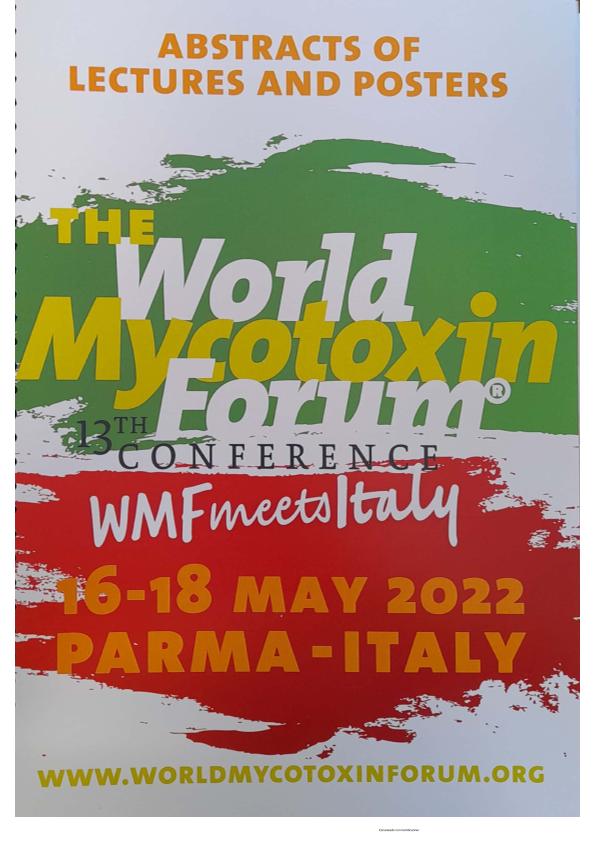Mostrar el registro sencillo del ítem
dc.contributor.author
Alaniz Zanon, Maria Silvina

dc.contributor.author
Oddino, Claudio Marcelo

dc.contributor.author
Giovanini, D.
dc.contributor.author
Barbero, C.
dc.contributor.author
Chiotta, María Laura

dc.contributor.author
Chulze, Sofia Noemi

dc.date.available
2024-02-26T15:33:04Z
dc.date.issued
2022
dc.identifier.citation
Bioformulate to reduce the accumulation of aflatoxins in maize based on a biopolymer as a carrier and support for growth of the biocontrol agent; World Mycotoxin Forum 13th Conference; Parma; Italia; 2022; 136-137
dc.identifier.uri
http://hdl.handle.net/11336/228437
dc.description.abstract
Maize (Zea mays L.) is the cereal with the highest volume of production worldwide, and the second most important in Argentina. The presence of aflatoxins in the different stages of the maize agri-food chain is a current problem in food safety and it is caused by the contamination with species of Aspergillus section Flavi, mainly A. flavus. During many years the research group has focused on the development of a biological control strategy based on the competitive exclusion mechanism. Several studies have demonstrated the effectiveness of the non-toxicogenic A. flavus AFCHG2 strain developed by solid state fermentation on long grain rice. However, considering the United Nations sustainable development goal of zero hunger, it was proposed to replace this substrate and to develop a biopolymer that allows the growth and transport of the biological control agent to be applied to crops such as maize and peanuts. In this sense, different natural, economic and starch-rich substrates were analysed: cassava starch (10 and 15%), rice flour (10 and 15%) and maize starch (5, 10 and 15%). In addition, urea was added as a nitrogen source, and citric acid as promoter of greater crosslinking of starch chains. Also, the development of the biocontrol strain in polymers with the addition of glucose or sucrose was evaluated. The diameter of the pores of each polymer was determined and those with a pore diameter of 93-97 µm were selected assuming they allow a better use of the entire substrate by the biological control agent. In addition, the growth of the biological control strain in the different preparations was analysed. The synthesis of this biopolymer included stages of gelation, cooling, freezing, thawing, drying, sterilization and curing, hydration, pH regulation, inoculation, incubation and final drying. The effectiveness of the bioformulate evaluated under field showed a reduction of 81% in aflatoxin accumulation in maize kernels in comparison with the non-inoculated controls. The development of this biotechnological tool allowed us to present a process and product patent that is currently pending. In addition, it offers to producers an eco-friendly, economical and safe alternative that contributes to food quality and safety.
dc.format
application/pdf
dc.language.iso
eng
dc.publisher
World Mycotoxin Forum
dc.rights
info:eu-repo/semantics/openAccess
dc.rights.uri
https://creativecommons.org/licenses/by-nc-sa/2.5/ar/
dc.subject
MAIZE
dc.subject
AFLATOXINS
dc.subject
BIOCONTROL
dc.subject
BIOPOLYMER
dc.subject.classification
Biología Celular, Microbiología

dc.subject.classification
Ciencias Biológicas

dc.subject.classification
CIENCIAS NATURALES Y EXACTAS

dc.title
Bioformulate to reduce the accumulation of aflatoxins in maize based on a biopolymer as a carrier and support for growth of the biocontrol agent
dc.type
info:eu-repo/semantics/publishedVersion
dc.type
info:eu-repo/semantics/conferenceObject
dc.type
info:ar-repo/semantics/documento de conferencia
dc.date.updated
2024-02-22T14:25:05Z
dc.journal.pagination
136-137
dc.journal.pais
Italia

dc.journal.ciudad
Parma
dc.description.fil
Fil: Alaniz Zanon, Maria Silvina. Universidad Nacional de Río Cuarto. Facultad de Ciencias Exactas Fisicoquímicas y Naturales. Instituto de Investigación en Micología y Micotoxicología. - Consejo Nacional de Investigaciones Científicas y Técnicas. Centro Científico Tecnológico Conicet - Córdoba. Instituto de Investigación en Micología y Micotoxicología; Argentina
dc.description.fil
Fil: Oddino, Claudio Marcelo. Universidad Nacional de Río Cuarto. Facultad de Ciencias Exactas Fisicoquímicas y Naturales. Instituto de Investigación en Micología y Micotoxicología. - Consejo Nacional de Investigaciones Científicas y Técnicas. Centro Científico Tecnológico Conicet - Córdoba. Instituto de Investigación en Micología y Micotoxicología; Argentina
dc.description.fil
Fil: Giovanini, D.. Universidad Nacional de Río Cuarto. Facultad de Ciencias Exactas Fisicoquímicas y Naturales. Instituto de Investigación en Micología y Micotoxicología. - Consejo Nacional de Investigaciones Científicas y Técnicas. Centro Científico Tecnológico Conicet - Córdoba. Instituto de Investigación en Micología y Micotoxicología; Argentina
dc.description.fil
Fil: Barbero, C.. Universidad Nacional de Río Cuarto; Argentina
dc.description.fil
Fil: Chiotta, María Laura. Universidad Nacional de Río Cuarto. Facultad de Ciencias Exactas Fisicoquímicas y Naturales. Instituto de Investigación en Micología y Micotoxicología. - Consejo Nacional de Investigaciones Científicas y Técnicas. Centro Científico Tecnológico Conicet - Córdoba. Instituto de Investigación en Micología y Micotoxicología; Argentina
dc.description.fil
Fil: Chulze, Sofia Noemi. Universidad Nacional de Río Cuarto. Facultad de Ciencias Exactas Fisicoquímicas y Naturales. Instituto de Investigación en Micología y Micotoxicología. - Consejo Nacional de Investigaciones Científicas y Técnicas. Centro Científico Tecnológico Conicet - Córdoba. Instituto de Investigación en Micología y Micotoxicología; Argentina
dc.relation.alternativeid
info:eu-repo/semantics/altIdentifier/url/https://www.bastiaanse-communication.com/WMF2021-2022/media/book%20of%20abstracts%20WMFmeetsITALY%20final.pdf
dc.conicet.rol
Autor

dc.conicet.rol
Autor

dc.conicet.rol
Autor

dc.conicet.rol
Autor

dc.conicet.rol
Autor

dc.conicet.rol
Autor

dc.coverage
Internacional
dc.type.subtype
Conferencia
dc.description.nombreEvento
World Mycotoxin Forum 13th Conference
dc.date.evento
2022-05-16
dc.description.ciudadEvento
Parma
dc.description.paisEvento
Italia

dc.type.publicacion
Book
dc.description.institucionOrganizadora
World Mycotoxin Forum
dc.source.libro
The World Mycotoxin Forum 13th conference
dc.source.revista
World Mycotoxin Forum 13th Conference
dc.date.eventoHasta
2022-05-18
dc.type
Conferencia
Archivos asociados
